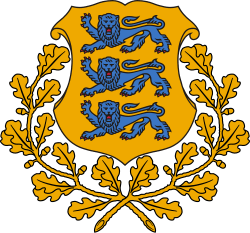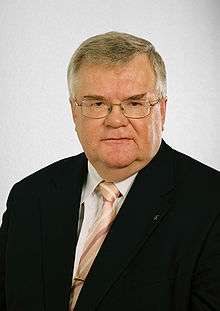Estonian parliamentary election, 2011
| | |||||||||||||||||||||||||||||||||||||||||||||||||||||||||||||||||||||
| |||||||||||||||||||||||||||||||||||||||||||||||||||||||||||||||||||||
| |||||||||||||||||||||||||||||||||||||||||||||||||||||||||||||||||||||
| |||||||||||||||||||||||||||||||||||||||||||||||||||||||||||||||||||||
 |
| This article is part of a series on the politics and government of Estonia |
A parliamentary election was held in Estonia on 6 March 2011, with e-voting between 24 February and 2 March 2011.
The 101 members of the Riigikogu (Parliament of Estonia) were elected using a form of proportional representation for a four-year term. The seats were allocated using a modified D'Hondt method. The country is divided into twelve multi-mandate electoral districts. There is a nationwide threshold of 5% for party lists, but if the number of votes cast for a candidate exceeds or equals the simple quota (which shall be obtained by dividing the number of valid votes cast in the electoral district by the number of mandates in the district) he or she is elected.
Pre-election polls put the Reform Party, led by Prime Minister Andrus Ansip, ahead of its main rival, the opposition Centre Party. The former is right of centre, the latter is considered populist, slightly to the left on economic matters. Both parties are members of the European Liberal Democrat and Reform Party.
The election was marked by the highest number of running independents (32) since 1992. Several independent candidates were members of the Estonian Patriotic Movement.[1]
Seats by electoral district
| The district number | Electoral District | Seats |
|---|---|---|
| 1 | Haabersti, Põhja-Tallinn and Kristiine districts in Tallinn | 9 |
| 2 | Kesklinn, Lasnamäe and Pirita districts in Tallinn | 11 |
| 3 | Mustamäe and Nõmme districts in Tallinn | 8 |
| 4 | Harjumaa (without Tallinn) and Raplamaa counties | 14 |
| 5 | Hiiumaa, Läänemaa and Saaremaa counties | 6 |
| 6 | Lääne-Virumaa county | 5 |
| 7 | Ida-Virumaa county | 8 |
| 8 | Järvamaa and Viljandimaa counties | 8 |
| 9 | Jõgevamaa and Tartumaa counties (without Tartu) | 7 |
| 10 | Tartu city | 8 |
| 11 | Võrumaa, Valgamaa and Põlvamaa counties | 9 |
| 12 | Pärnumaa county | 8 |
Opinion polling
| Party | PM candidate | Seats after 2007 elections |
Rating |
|---|---|---|---|
| Estonian Reform Party | Andrus Ansip | 31 | 43% (November 2010, Estonia),[2] 33% (November 2010, Tallinn),[2] 36% (December 2010),[3] 36% (January 2011, TNS Emor),[3] 25% (January 2011, Turu-Uuringute),[4] 39% (13 February 2011),[5] 28% (25 February 2011, TNS Emor)[6] |
| Estonian Centre Party | Edgar Savisaar | 29 | 23% (November 2010, Estonia),[2] 31% (November 2010, Tallinn),[2] 23% (December 2010),[3] 23% (January 2011, TNS Emor),[3] 19% (January 2011, Turu-Uuringute),[4] 25% (25 February 2011, TNS Emor)[6] |
| Union of Pro Patria and Res Publica | Mart Laar | 19 | 15% (November 2010, Estonia),[2] 20% (November 2010, Tallinn),[2] 15% (December 2010),[3] 16% (January 2011, TNS Emor),[3] 12% (January 2011, Turu-Uuringute),[4] 21% (25 February 2011, TNS Emor)[6] |
| Social Democratic Party | Sven Mikser | 10 | 11% (November 2010, Estonia),[3] 9% (November 2010, Tallinn),[2] 13% (December 2010),[3] 14% (January 2011, TNS Emor),[3] 9% (January 2011, Turu-Uuringute)[4] 16% (25 February 2011, TNS Emor)[6] |
| Estonian Greens | Aleksei Lotman | 6 | 3% (November 2010, Estonia),[3] 4% (November 2010, Tallinn),[2] 5% (December 2010),[3] 4% (January 2011, TNS Emor),[3] 2% (January 2011, Turu-Uuringute)[4] 4% (25 February 2011, TNS Emor)[6] |
| People's Union of Estonia | Andrus Blok | 6 | 2% (November 2010, Estonia),[3] 1% (November 2010, Tallinn),[2] 4% (December 2010),[3] 2% (January 2011, TNS Emor),[3] 2% (January 2011, Turu-Uuringute)[4] 2% (25 February 2011, TNS Emor)[6] |
| Party of Estonian Christian Democrats | Peeter Võsu | 0 | |
| Estonian Independence Party | Vello Leito | 0 | |
| Russian Party in Estonia | Dimitri Klenski | 0 | |
| Non-party candidates | 0 | 9% (January 2011, Turu-Uuringute)[7] |
Results

| Party | Votes | % | Seats | +/– |
|---|---|---|---|---|
| Estonian Reform Party | 164,255 | 28.6 | 33 | +2 |
| Estonian Centre Party | 134,124 | 23.3 | 26 | –3 |
| Pro Patria and Res Publica Union | 118,023 | 20.5 | 23 | +4 |
| Social Democratic Party | 98,307 | 17.1 | 19 | +9 |
| Estonian Greens | 21,824 | 3.8 | 0 | –6 |
| People's Union of Estonia | 12,184 | 2.1 | 0 | –6 |
| Russian Party in Estonia | 5,029 | 0.9 | 0 | 0 |
| Party of Estonian Christian Democrats | 2,934 | 0.5 | 0 | 0 |
| Estonian Independence Party | 2,571 | 0.4 | 0 | 0 |
| Independents | 15,882 | 2.8 | 0 | 0 |
| Invalid/blank votes | 5,131 | – | – | – |
| Total | 580,264 | 100 | 101 | 0 |
| Registered voters/turnout | 913,346 | 63.5 | – | – |
| Source: VVK | ||||
Report on Internet voting
The Office for Democratic Institutions and Human Rights of the Organization for Security and Co-operation in Europe observed this election and issued a report with a number of recommendations.[8]
References
- ↑ Delfi: Telestuudiosse kogunes 28 üksikkandidaati
- 1 2 3 4 5 6 7 8 9 "Исследование Emor: реформисты опережают центристов в столице" (in Russian). DELFI. 2010-10-24.
- 1 2 3 4 5 6 7 8 9 10 11 12 13 14 15 Скандал снизил популярность центристов у эстонцев, но поднял среди русских (in Russian). Postimees. 2011-01-28.
- 1 2 3 4 5 6 По популярности центристы по-прежнему уступают реформистам (in Russian). Eesti Rahvusringhääling. 08.02.2011. Check date values in:
|date=(help) - ↑ Эстонская общественная телерадиовещательная корпорация (in Russian). Eesti Rahvusringhääling. 2011-02-13.
- 1 2 3 4 5 6 "Reformierakonna toetus langes veebruaris 28 protsendile" (in Estonian). Postimees. 2011-02-25.
- ↑ "Valimiste teise koha eest võitlevad kolm erakonda" (in Estonian). Postimees. 01.03.2011. Check date values in:
|date=(help) - ↑ OSCE (2011-05-16). "OSCE/ODIHR Election Assessment Mission Report - ESTONIA PARLIAMENTARY ELECTIONS 6 March 2011". Retrieved 2011-05-18.
External links
- Estonian National Electoral Committee
- Poll ratings of political parties
- NSD: European Election Database - Estonia publishes regional level election data; allows for comparisons of election results, 1990-2011
_crop.jpg)


